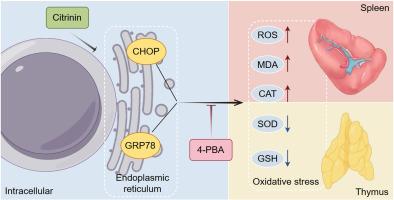Endoplasmic reticulum stress promotes oxidative stress: A novel mechanism of citrinin-induced thymus and spleen injury
IF 2.4
4区 医学
Q2 PHARMACOLOGY & PHARMACY
引用次数: 0
Abstract
Citrinin (CTN) is a mycotoxin that is widespread and can contaminate a wide range of food products, posing a threat to human and animal health. The spleen and thymus are important immune organs of the body, and the damaging effects of CTN on immune organs and their mechanism are still unclear. In this study, we induced spleen and thymus injury in mice by exposure to different doses of CTN (0, 1.25, 5, or 20 mg/kg) and preliminarily investigated the damage mechanisms. It was observed that CTN exposure caused immune damage to the thymus and spleen, which are immune organs in mice. In addition, CTN exposure decreased the content of glutathione (GSH), an antioxidant, and the activities of antioxidant enzymes, including superoxide dismutase (SOD) and catalase (CAT); it also increased the levels of oxidized products such as reactive oxygen species (ROS)and malondialdehyde (MDA). These results suggested that CTN induced oxidative stress in the thymus and spleen. The present study also found that CTN exposure significantly increased the expression of endoplasmic reticulum (ER) stress signature proteins, including C/EBP homologous protein (CHOP) and glucose-regulated protein 78(GRP78). Notably, pretreatment with the ER stress inhibitor 4-phenylbutyric acid (4-PBA, 240 mg/kg, intraperitoneally) attenuated CTN-induced oxidative stress in the spleen and thymus of mice and partially alleviated histopathological damage, demonstrating that inhibition of ER stress may be a novel strategy to prevent or treat CTN-induced immune organ damage.

内质网应激促进氧化应激:橙霉素诱导胸腺和脾脏损伤的新机制。
柑桔毒素(Citrinin, CTN)是一种广泛存在的霉菌毒素,可污染多种食品,对人类和动物健康构成威胁。脾脏和胸腺是机体重要的免疫器官,CTN对免疫器官的破坏作用及其机制尚不清楚。本研究通过不同剂量的CTN(0、1.25、5、20 mg/kg)诱导小鼠脾脏和胸腺损伤,并初步探讨其损伤机制。观察到CTN暴露可引起小鼠免疫器官胸腺和脾脏的免疫损伤。此外,CTN暴露降低了抗氧化剂谷胱甘肽(GSH)的含量和抗氧化酶,包括超氧化物歧化酶(SOD)和过氧化氢酶(CAT)的活性;它还增加了氧化产物的水平,如活性氧(ROS)和丙二醛(MDA)。提示CTN可诱导胸腺和脾脏氧化应激。本研究还发现,CTN暴露显著增加内质网(ER)应激特征蛋白的表达,包括C/EBP同源蛋白(CHOP)和葡萄糖调节蛋白78(GRP78)。值得注意的是,内质网应激抑制剂4-苯基丁酸(4-PBA, 240 mg/kg,腹腔注射)预处理可减轻ctn诱导的小鼠脾脏和胸腺氧化应激,部分减轻组织病理学损伤,表明抑制内质网应激可能是预防或治疗ctn诱导的免疫器官损伤的一种新策略。
本文章由计算机程序翻译,如有差异,请以英文原文为准。
求助全文
约1分钟内获得全文
求助全文
来源期刊

Toxicon
医学-毒理学
CiteScore
4.80
自引率
10.70%
发文量
358
审稿时长
68 days
期刊介绍:
Toxicon has an open access mirror Toxicon: X, sharing the same aims and scope, editorial team, submission system and rigorous peer review. An introductory offer Toxicon: X - full waiver of the Open Access fee.
Toxicon''s "aims and scope" are to publish:
-articles containing the results of original research on problems related to toxins derived from animals, plants and microorganisms
-papers on novel findings related to the chemical, pharmacological, toxicological, and immunological properties of natural toxins
-molecular biological studies of toxins and other genes from poisonous and venomous organisms that advance understanding of the role or function of toxins
-clinical observations on poisoning and envenoming where a new therapeutic principle has been proposed or a decidedly superior clinical result has been obtained.
-material on the use of toxins as tools in studying biological processes and material on subjects related to venom and antivenom problems.
-articles on the translational application of toxins, for example as drugs and insecticides
-epidemiological studies on envenoming or poisoning, so long as they highlight a previously unrecognised medical problem or provide insight into the prevention or medical treatment of envenoming or poisoning. Retrospective surveys of hospital records, especially those lacking species identification, will not be considered for publication. Properly designed prospective community-based surveys are strongly encouraged.
-articles describing well-known activities of venoms, such as antibacterial, anticancer, and analgesic activities of arachnid venoms, without any attempt to define the mechanism of action or purify the active component, will not be considered for publication in Toxicon.
-review articles on problems related to toxinology.
To encourage the exchange of ideas, sections of the journal may be devoted to Short Communications, Letters to the Editor and activities of the affiliated societies.
 求助内容:
求助内容: 应助结果提醒方式:
应助结果提醒方式:


